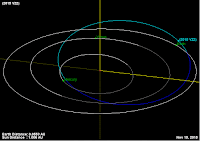Asteroid
2015 VY2 passed by the Earth at a distance of 18 550 000 km (48.6 times
the average distance between the Earth and the Moon, or 12.4% of the
average distance between the Earth and the Sun), slightly after 10.00 pm
GMT on Wednesday 11 November 2015. There
was no danger of the asteroid hitting us, though had it done so it
would have presented a genuine threat. 2015 VY2 has an estimated
equivalent diameter of 38-120 m (i.e. a spherical body with the same
mass would be 38-120 m in diameter), and an object towards the upper end
of this range would pass through the atmosphere and directly impact the
ground with a force of about 55 megatons (about 3235 times the
explosive energy of the Hiroshima bomb), causing devastation over a wide
area and creating a crater over 1.5 km across, and resulting in global
climatic problems that could last for years or even decades.
The calculated orbit of 2015 VY2. JPL Small Body Database.
2015 VY2 was discovered on 6 November 2015 (five days after its closest approach to the Earth) by the University of Arizona's Mt. Lemmon Survey at the Steward Observatory on
Mount Lemmon in the Catalina Mountains north of Tucson. The designation
2015 VY2 implies that the asteroid was the 74th object (object Y2) discovered in the first half of November 2015 (period 2015 V).
2015 VY2 has a 573 day orbital period and an eccentric orbit tilted at an
angle of 15.8° to the plane of the Solar System that takes it from 0.49
AU from the Sun (i.e. 49% of the average distance at which the Earth
orbits the Sun, and slightly outside the orbit of Mercury) to 2.21 AU from the Sun (i.e. 221% of the average
distance at which the Earth orbits the Sun, considerably more than the
distance at which Mars orbits the Sun). It is therefore classed as an
Apollo Group Asteroid (an asteroid that is on average further from the
Sun than the Earth, but which does get closer). 2015 VY2 also has occasional
close encounters with the planet Venus, with the next predicted in February 2016.
See also...
 Asteroid 2015 VT64 passes the Earth. Asteroid
2015 VT64 passed by the Earth at a distance of 3 772 000 km (9.68
times the average distance between the Earth and the Moon, or 2.49% of
the average distance between the Earth and the Sun), slightly before
7.15
pm on Monday 9 November...
Asteroid 2015 VT64 passes the Earth. Asteroid
2015 VT64 passed by the Earth at a distance of 3 772 000 km (9.68
times the average distance between the Earth and the Moon, or 2.49% of
the average distance between the Earth and the Sun), slightly before
7.15
pm on Monday 9 November... Leonid Meteor Shower falls this week. Each year between 15 and 18 November (approximately), typically peaking between midnight and dawn on 18 November, the the Earth
encounters the Leonid Meteors, one of...
Leonid Meteor Shower falls this week. Each year between 15 and 18 November (approximately), typically peaking between midnight and dawn on 18 November, the the Earth
encounters the Leonid Meteors, one of... Asteroid 2015 VZ2 passes the Earth. Asteroid
2015 VZ2 passed by the Earth at a distance of 5 294 000 km (10.8 times
the average distance between the Earth and the Moon, or 3.54% of the
average distance between the Earth and the Sun), slightly after 2.50 am
GMT on Sunday 8 November 2015. There...
Asteroid 2015 VZ2 passes the Earth. Asteroid
2015 VZ2 passed by the Earth at a distance of 5 294 000 km (10.8 times
the average distance between the Earth and the Moon, or 3.54% of the
average distance between the Earth and the Sun), slightly after 2.50 am
GMT on Sunday 8 November 2015. There...
Follow Sciency Thoughts on Facebook.

